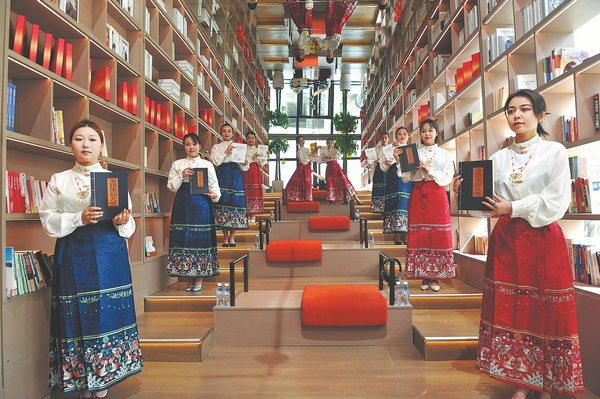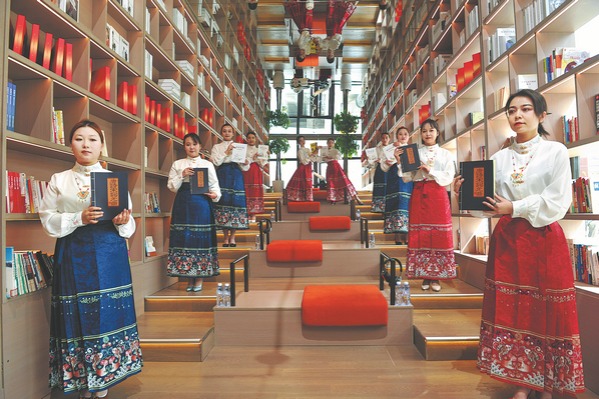
Local women wearing skirts featuring horse faces at a bookstore and bar in Urumqi, Xinjiang, in April. China Daily
Ask Generation Z, those born after 1995 and in the 2000s, what is the current fashion trend in China, and they will likely answer “New Chinese Style.” After gaining immense popularity during the Chinese New Year in February this year, the organic fusion of traditional Chinese aesthetics and modern style has continued to captivate people’s hearts throughout spring and summer, becoming a buzzword in the domestic consumer market.
New Chinese clothing is generally defined as a seamless integration of traditional Chinese elements and contemporary style, embracing traditional aesthetics and cultural heritage, but also integrating materials, techniques and technologies emerging from modern science.
“New China Style” remains a hot topic on social media platforms such as Douyin and Xiaohongshu. According to e-commerce data from short video platform Kuaishou, in the first quarter of this year, orders for “New China Style” products increased 700 percent year-on-year, while orders for Hanfu, the traditional dress of the Han people, increased nearly 300 percent.
“Our orders are booked up for six months in advance, and our sales have experienced a compound annual growth rate of over 100 percent,” said Lin Qi, a clothing brand founder and heir to the craftsmanship of mamen skirts, a type of Hanfu featuring a high, flat front and pleated sides that originated in the Song dynasty (960-1279) and was popular in the Ming dynasty (1368-1644) and Qing dynasties (1644-1911).
In 2016, Lin started making unique horse-face skirts, but initially only sold a dozen or so a year. But in just a few years, her company’s annual sales of horse-face skirts have skyrocketed to an astounding 100,000. Looking back at this remarkable growth, Lin says, “The market has changed significantly.” Now, the majority of her customers are from the younger generation.
When asked about the appeal of new Chinese fashion, many people born after 1995 say that its inherent beauty resonates with their cultural genes. What’s more, what excites young people is the attractive designs that exude a stronger sense of style and a modern vibe.
A closer look at the “New China Style” trend reveals a fascinating blend of fashion and sophistication. Whether it’s the exquisitely crafted button designs or the artistry of embroidery that embodies intangible cultural heritage, this blend always blends seamlessly with contemporary clothing styles and silhouettes, perfectly capturing the aesthetic tastes of young people.
For example, horse-face skirts have evolved into more diverse fashion items and become more versatile. They are now available in a variety of lengths, from full-length to midi to knee-length, to suit different occasions. Fabrics have also evolved from heavy wool knits to lightweight cotton, linen and silk to meet the demands of different seasons.
From the traditional Chinese qipao dress to Hanfu, most popular fashion items are reinterpretations of tradition. “We have collected hundreds of traditional brocade patterns from the Song Dynasty, studied the weaving techniques and spent considerable time and money refining them to suit modern aesthetic sensibilities,” says Wu Jianhua, president of the Silk Research and Development Company in Suzhou, Jiangsu province.
Wu’s company has also researched and developed elastic Song Brocade, aiming to make the fabric wrinkle-resistant, colour vibrant and comfortable to wear, making it more suitable for modern clothing.
Xue Yadi, born in 2000, praised the “new Chinese style” clothes, saying they “not only look beautiful, but are also lightweight”, adding: “It makes me feel proud when I wear them.”
“The popularity of traditional costumes is closely related to growing interest in traditional culture. Consumers are not only willing to pay for the costumes themselves, but they also value them for their aesthetic significance and cultural value. This phenomenon reflects the people’s strong confidence in their culture,” said Yang Xiaodong, vice president of the China National Clothing Association.

